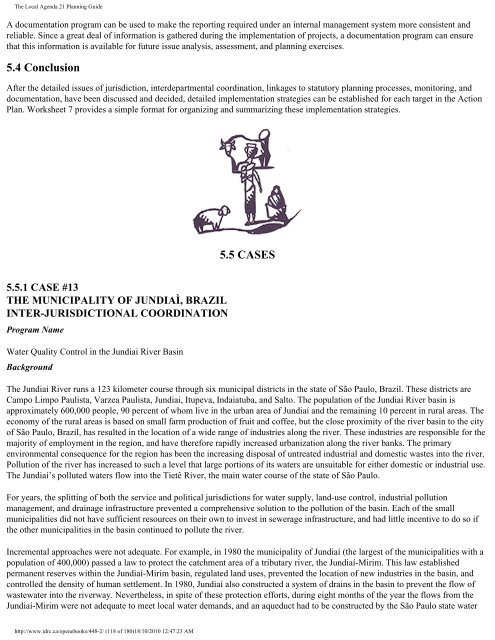The Local Agenda 21 Planning Guide - Democrats Against UN ...
The Local Agenda 21 Planning Guide - Democrats Against UN ...
The Local Agenda 21 Planning Guide - Democrats Against UN ...
You also want an ePaper? Increase the reach of your titles
YUMPU automatically turns print PDFs into web optimized ePapers that Google loves.
<strong>The</strong> <strong>Local</strong> <strong>Agenda</strong> <strong>21</strong> <strong>Planning</strong> <strong>Guide</strong><br />
A documentation program can be used to make the reporting required under an internal management system more consistent and<br />
reliable. Since a great deal of information is gathered during the implementation of projects, a documentation program can ensure<br />
that this information is available for future issue analysis, assessment, and planning exercises.<br />
5.4 Conclusion<br />
After the detailed issues of jurisdiction, interdepartmental coordination, linkages to statutory planning processes, monitoring, and<br />
documentation, have been discussed and decided, detailed implementation strategies can be established for each target in the Action<br />
Plan. Worksheet 7 provides a simple format for organizing and summarizing these implementation strategies.<br />
5.5 CASES<br />
5.5.1 CASE #13<br />
THE M<strong>UN</strong>ICIPALITY OF J<strong>UN</strong>DIAÌ, BRAZIL<br />
INTER-JURISDICTIONAL COORDINATION<br />
Program Name<br />
Water Quality Control in the Jundiai River Basin<br />
Background<br />
<strong>The</strong> Jundiai River runs a 123 kilometer course through six municipal districts in the state of São Paulo, Brazil. <strong>The</strong>se districts are<br />
Campo Limpo Paulista, Varzea Paulista, Jundiai, Itupeva, Indaiatuba, and Salto. <strong>The</strong> population of the Jundiai River basin is<br />
approximately 600,000 people, 90 percent of whom live in the urban area of Jundiaí and the remaining 10 percent in rural areas. <strong>The</strong><br />
economy of the rural areas is based on small farm production of fruit and coffee, but the close proximity of the river basin to the city<br />
of São Paulo, Brazil, has resulted in the location of a wide range of industries along the river. <strong>The</strong>se industries are responsible for the<br />
majority of employment in the region, and have therefore rapidly increased urbanization along the river banks. <strong>The</strong> primary<br />
environmental consequence for the region has been the increasing disposal of untreated industrial and domestic wastes into the river.<br />
Pollution of the river has increased to such a level that large portions of its waters are unsuitable for either domestic or industrial use.<br />
<strong>The</strong> Jundiai’s polluted waters flow into the Tietê River, the main water course of the state of São Paulo.<br />
For years, the splitting of both the service and political jurisdictions for water supply, land-use control, industrial pollution<br />
management, and drainage infrastructure prevented a comprehensive solution to the pollution of the basin. Each of the small<br />
municipalities did not have sufficient resources on their own to invest in sewerage infrastructure, and had little incentive to do so if<br />
the other municipalities in the basin continued to pollute the river.<br />
Incremental approaches were not adequate. For example, in 1980 the municipality of Jundiaí (the largest of the municipalities with a<br />
population of 400,000) passed a law to protect the catchment area of a tributary river, the Jundiaí-Mirim. This law established<br />
permanent reserves within the Jundiaí-Mirim basin, regulated land uses, prevented the location of new industries in the basin, and<br />
controlled the density of human settlement. In 1980, Jundiaí also constructed a system of drains in the basin to prevent the flow of<br />
wastewater into the riverway. Nevertheless, in spite of these protection efforts, during eight months of the year the flows from the<br />
Jundiaí-Mirim were not adequate to meet local water demands, and an aqueduct had to be constructed by the São Paulo state water<br />
http://www.idrc.ca/openebooks/448-2/ (118 of 180)18/10/2010 12:47:23 AM










